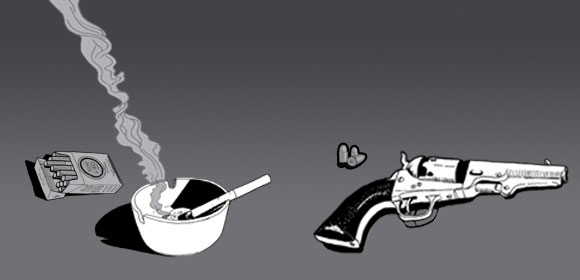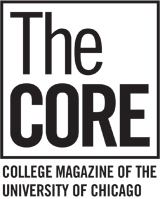
Marginalia
Top Ten: Double Feature
Robert Pippin, the Evelyn Stefansson Nef distinguished service professor in the Committee on Social Thought, Philosophy, and the College, was trained in modern German philosophy and has published prolifically on Kant, Hegel, and Nietzsche. His recent work, including the new book Hollywood Westerns and American Myth (Yale University Press, 2010) casts a philosophical eye on Westerns and film noir. Ready your Netflix queue for his favorites in each genre.
Ten Noirs
Out of the Past
(1947, Jacques Tourneur)
A man’s past keeps returning from out of the past, and he keeps trying to escape from out of the past. Perhaps the most beautifully photographed noir.
Lady from Shanghai
(1948, Orson Welles)
One of the greatest closing scenes in film history, the “Maze of Mirrors,” and a complex working-out of the problems of trust and deception.
Double Indemnity
(1944, Billy Wilder)
Together with Out of the Past, one of the paradigmatic, genre-defining noirs, both visually and thematically. An overwhelming performance by the greatest screen actress, Barbara Stanwyck.
Detour
(1945, Edgar G. Ulmer)
Certainly the greatest “cheaply made” film. A 68-minute wonder of a treatment of both fate and the temptations of the appeal to fate.
The Killers
(1946, Robert Siodmak)
Beautiful atmospherics, and a great performance by Burt Lancaster as a physically powerful man reduced to near passivity by the love of a woman.
Laura
(1944, Otto Preminger)
A great noir theme—the difference (if any) between love and obsession. Dana Andrews in a typical noir role, a passive agent, very low-affect, acted on more than acting.
The Big Heat
(1953, Fritz Lang)
Justice and revenge, and the difference (if any) between them, and a great treatment of the darker side of any legal order.
In a Lonely Place
(1950, Nicholas Ray)
A brilliant, moody treatment of one’s own character as a kind of fate, and perhaps Bogart’s best performance.
D.O.A.
(1950, Rudolph Maté)
An existential noir. A man is dying, has a day to live, and all he wants to know is “why?” Don’t we all?
Kiss Me Deadly
(1955, Robert Aldrich)
For many noir buffs, the “last noir,” already mannered, a bit of a parody of itself; in many ways the best meta-noir.
Ten Westerns
The Searchers
(1956, John Ford)
Not only the greatest Western but one of the greatest films ever made. A brutally frank treatment of the role of race and racial hatred in the American social bond.
Red River
(1948, Howard Hawks)
Charismatic authority (John Wayne) and the difficult transition to fraternal, shared rule (Montgomery Clift). Visually stunning.
The Man Who Shot Liberty Valance
(1962, John Ford)
The role of myth and mythic memory in the formation of the political identity of a community, and the dangers of relying on such myth.
Stagecoach
(1939, John Ford)
The first brilliant Western, and still one of Ford’s best. A great nervous, edgy performance by Claire Trevor.
Ride the High Country
(1962, Sam Peckinpah)
Many great Westerns are about the end of the West and the obsolescence of the heroic, martial virtues. This may be the best such treatment. (aka Guns in the Afternoon)
The Naked Spur
(1953, Anthony Mann)
Mann made a number of “noirish” Westerns and this is my favorite. One of the many examples of the very different sort of actor Jimmy Stewart became after the war.
High Noon
(1952, Fred Zimmerman)
A dark treatment about the limits (severe limits) of political allegiance and a classic performance by Gary Cooper.
Seven Men From Now
(1956, Budd Boetticher)
What count as the masculine virtues in a transition from lawlessness to order and a settled, domestic life? All of Boetticher’s films concern this theme, but this is my favorite.
Shane
(1953, George Stevens)
The obsolescent (or not quite yet obsolescent) gunfighter theme again, but this time entwined with a romantic triangle and an interrogation of the bourgeois virtues.
3:10 to Yuma
(1957, Delmer Daves)
Much better than the recent remake, yet another sort of interrogation of the heroic and martial virtues and their place in a legal order. One of Glenn Ford’s best performances: sly, subtle, understated, yet quite powerful.
